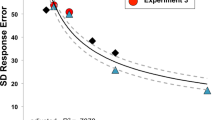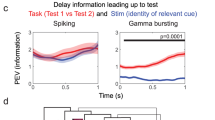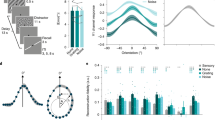Abstract
Items held in working memory can be either attended or not, depending on their current behavioral relevance. It has been suggested that unattended contents might be solely retained in an activity-silent form. Instead, we demonstrate here that encoding unattended contents involves a division of labor. While visual cortex only maintains attended items, intraparietal areas and the frontal eye fields represent both attended and unattended items.
This is a preview of subscription content, access via your institution
Access options
Access Nature and 54 other Nature Portfolio journals
Get Nature+, our best-value online-access subscription
$29.99 / 30 days
cancel any time
Subscribe to this journal
Receive 12 print issues and online access
$209.00 per year
only $17.42 per issue
Buy this article
- Purchase on Springer Link
- Instant access to full article PDF
Prices may be subject to local taxes which are calculated during checkout


Similar content being viewed by others
References
Baddeley, A. D. Working Memory (Clarendon Press, Oxford, 1986).
Christophel, T. B., Klink, P. C., Spitzer, B., Roelfsema, P. R. & Haynes, J.-D. Trends Cogn. Sci. 21, 111–124 (2017).
Stokes, M. G. Trends Cogn. Sci. 19, 394–405 (2015).
Mongillo, G., Barak, O. & Tsodyks, M. Science 319, 1543–1546 (2008).
Larocque, J. J., Lewis-Peacock, J. A. & Postle, B. R. Front. Hum. Neurosci. 8, 5 (2014).
Lewis-Peacock, J. A., Drysdale, A. T., Oberauer, K. & Postle, B. R. J. Cogn. Neurosci. 24, 61–79 (2012).
LaRocque, J. J., Riggall, A. C., Emrich, S. M. & Postle, B. R. Cereb. Cortex 27, 4881–4890 (2017).
Wolff, M. J., Jochim, J., Akyürek, E. G. & Stokes, M. G. Nat. Neurosci. 20, 864–871 (2017).
Olivers, C. N. L., Peters, J., Houtkamp, R. & Roelfsema, P. R. Trends Cogn. Sci. 15, 327–334 (2011).
Allefeld, C. & Haynes, J.-D. Neuroimage 89, 345–357 (2014).
Harrison, S. A. & Tong, F. Nature 458, 632–635 (2009).
Serences, J. T., Ester, E. F., Vogel, E. K. & Awh, E. Psychol. Sci. 20, 207–214 (2009).
Ester, E. F., Sprague, T. C. & Serences, J. T. Neuron 87, 893–905 (2015).
Ester, E. F., Serences, J. T. & Awh, E. J. Neurosci. 29, 15258–15265 (2009).
Hebb, D. O. The Organization of Behavior(Wiley, New York, 1949).
Itskov, V., Hansel, D. & Tsodyks, M. Front. Comput. Neurosci. https://doi.org/10.3389/fncom.2011.00040 (2011).
Rerko, L. & Oberauer, K. J. Exp. Psychol. Learn. Mem. Cogn. 39, 1075–1096 (2013).
Emrich, S. M., Lockhart, H. A. & Al-Aidroos, N. J. Exp. Psychol. Hum. Percept. Perform. 43, 1454–1465 (2017).
Bae, G.-Y. & Luck, S. J. Vis. https://doi.org/10.1167/16.12.701 (2016).
Ester, E. F., Anderson, D. E., Serences, J. T. & Awh, E. J. Cogn. Neurosci. 25, 754–761 (2013).
Christophel, T. B., Hebart, M. N. & Haynes, J.-D. J. Neurosci. 32, 12983–12989 (2012).
Christophel, T. B. & Haynes, J.-D. Neuroimage 91, 43–51 (2014).
Christophel, T. B., Cichy, R. M., Hebart, M. N. & Haynes, J.-D. Neuroimage 106, 198–206 (2015).
Christophel, T. B., Allefeld, C., Endisch, C. & Haynes, J.-D. Cereb. Cortex https://doi.org/10.1093/cercor/bhx119 (2017)
Schneegans, S. & Bays, P. M. J. Cogn. Neurosci. 29, 1977–1994 (2017).
Brainard, D. H. Spat. Vis. 10, 433–436 (1997).
Pratte, M. S. & Tong, F. J. Vis. 14, 22 (2014).
Görgen, K., Hebart, M.N., Allefeld, C. & Haynes, J.-D. Neuroimage https://doi.org/10.1016/j.neuroimage.2017.12.083 (2017).
Friston, K. J. et al. Hum. Brain Mapp. 2, 189–210 (1994).
Wang, L., Mruczek, R. E. B., Arcaro, M. J. & Kastner, S. Cereb. Cortex 25, 3911–3931 (2015).
Ashburner, J. & Friston, K. J. Neuroimage 26, 839–851 (2005).
Timm, N. H. Applied Multivariate Analysis (Springer, New York, 2002).
Guggenmos, M., Wilbertz, G., Hebart, M. N. & Sterzer, P. eLife 5, e13388 (2016).
Haynes, J. D. & Rees, G. Nat. Neurosci. 8, 686–691 (2005).
Haynes, J.-D. & Rees, G. Curr. Biol. 15, 1301–1307 (2005).
Haynes, J.-D. & Rees, G. Nat. Rev. Neurosci. 7, 523–534 (2006).
Kamitani, Y. & Tong, F. Nat. Neurosci. 8, 679–685 (2005).
Soon, C. S., Brass, M., Heinze, H. J. & Haynes, J. D. Nat. Neurosci. 11, 543–545 (2008).
Sterzer, P., Haynes, J.-D. & Rees, G. J. Vis. 8, 10 (2008).
Cichy, R. M., Chen, Y. & Haynes, J. D. Neuroimage 54, 2297–2307 (2011).
Riggall, A. C. & Postle, B. R. J. Neurosci. 32, 12990–12998 (2012).
Lee, S.-H., Kravitz, D. J. & Baker, C. I. Nat. Neurosci. 16, 997–999 (2013).
Bettencourt, K. C. & Xu, Y. Nat. Neurosci. 19, 150–157 (2016).
Schäfer, J. & Strimmer, K. Stat. Appl. Genet. Mol. Biol. https://doi.org/10.2202/1544-6115.1175 (2005).
Allefeld, C., Görgen, K. & Haynes, J.-D. Neuroimage 141, 378–392 (2016).
Dubois, J., de Berker, A. O. & Tsao, D. Y. J. Neurosci. 35, 2791–2802 (2015).
Haynes, J.-D. Neuron 87, 257–270 (2015).
Hebart, M. N. & Baker, C. I. Neuroimage https://doi.org/10.1016/j.neuroimage.2017.08.005 (2017).
Efron, B. & Tibshirani, R. J. An Introduction to the Bootstrap (CRC Press, Boca Raton, FL, USA, 1994).
Acknowledgements
This work was funded by the Bernstein Computational Neuroscience Program of the German Federal Ministry of Education and Research BMBF Grant 01GQ0411, by the Excellence Initiative of the German Federal Ministry of Education and Research and DFG Grants GSC86/1-2009, KFO247, HA 5336/1-1, SFB 940 and JA 945/3-1/SL185/1-1.
Author information
Authors and Affiliations
Contributions
T.B.C., P.I. and J.-D.H. designed the study. P.I. and C.Y. acquired data. T.B.C., P.I. and C.A. analyzed the data. T.B.C., P.I., C.A. and J.-D.H. wrote the manuscript.
Corresponding author
Ethics declarations
Competing interests
The authors declare no competing interests.
Additional information
Publisher’s note: Springer Nature remains neutral with regard to jurisdictional claims in published maps and institutional affiliations.
Integrated supplementary information
Supplementary Figure 1 Stimulus set.
The main experiment used a set of twelve orientations, six on the left and six on the right. On each side the stimulus set consisted of orientations that were 30° apart, but the two sets were separated by 15° to experimentally decorrelate the two conditions.
Supplementary Figure 2 Representation of attended and unattended memory items in different regions of the visual cortex.
Information about attended (AMI, circles) and unattended (UMI, squares) memory items as indicated by mean pattern distinctness D within different regions of the visual cortex. (n = 87 human subjects; error bars indicate SEM; *: p < 0.05; **: p < 0.01; ***: p < 0.001; Bonferroni corrected for multiple comparisons). Results were tested against chance using one-tailed one-sample t-tests (V1AMI: t86 = 3.34, p = 0.0006; V1UMI: t86 = -0.87, p = 0.81; V2AMI: t86 = 1.58, p = 0.059; V2UMI: t86 = 0.86, p = 0.19; V3AMI: t86 = 2.97, p = 0.002; V3UMI: t86 = 1.6, p = 0.057; V4AMI: t86 = 1.45, p = 0.076; V4UMI: t86 = 1.48, p = 0.071) and for differences between AMIs and UMIs using two-tailed paired-sample t-tests (V1: t86 = 3.42, p = 0.001; V2: t86 = 0.79, p = 0.43; V3: t86 = 0.61, p = 0.54; V4: t86 = 0.02, p = 0.98).
Supplementary Figure 3 Estimation of the probability of significance of the multivariate pattern analyses with a reduced number of subjects.
Probabilities were estimated using a bootstrapping procedure with 10000 iterations for each of the main multivariate pattern analyses, each area and each possible N ranging from 10 to 86. In each iteration, N values of D were drawn from the whole sample of 87 human subjects and a one-tailed one-sample t-test was testing against chance-level (D = 0) at an uncorrected threshold of p < 0.05. Please note that these estimates do not easily generalize to studies using a different stimulus set, different numbers of repetitions or an otherwise different experimental paradigm. Please further note that the qualitative difference in reliability of information in FEF for unattended over attended items is a result of a difference in variance.
Supplementary Figure 4 Representation of attended and unattended memory items across time.
Information about attended (AMI, circles) and unattended (UMI, squares) memory items as indicated by mean pattern distinctness D on a time-point by time-point basis. Vertical lines indicate the onset of the first cue and the two tasks. Grey panels demark the time-points used for the main analysis shown in Fig. 2. (n = 87 human subjects; error bars indicate SEM; Colored lines on the top part of the figure indicate time points with significant above-chance information at p < 0.05 for AMI [top] and UMI [bottom]; tested using one-tailed one-sample t-tests).
Supplementary Figure 5 Behavioral results.
Behavioral performance in the two-stage orientation change discrimination task shown separately for the first and second task in each trial. Data for the second task are shown separately for trials where the same item was probed twice (‘Repeat’) and where a different item was tested in the second task (‘Switch’). Mean proportion of correct responses (A; two-tailed Wilcoxon signed rank tests; Left: z = 6.40, p < 0.001; Right: z = 7.70, p < 0.001) and mean reaction time in seconds (B; two-sided Wilcoxon signed rank tests; Left: z = 1.10, p = 0.308; Right: z = 7.94, p < 0.001) are reported (n = 87 human subjects; error bars indicate SEM; *: p < 0.05; **: p < 0.01; ***: p < 0.001). Misses (2.44% ±0.26% SEM) were treated as incorrect responses to calculate proportions of correct responses and excluded from reaction time analyses. Miss rate did not differ significantly between conditions.
Supplementary information
Supplementary Text and Figures
Supplementary Figures 1–5
Rights and permissions
About this article
Cite this article
Christophel, T.B., Iamshchinina, P., Yan, C. et al. Cortical specialization for attended versus unattended working memory. Nat Neurosci 21, 494–496 (2018). https://doi.org/10.1038/s41593-018-0094-4
Received:
Accepted:
Published:
Issue Date:
DOI: https://doi.org/10.1038/s41593-018-0094-4
This article is cited by
-
Cycles of goal silencing and reactivation underlie complex problem-solving in primate frontal and parietal cortex
Nature Communications (2023)
-
Geometry of visuospatial working memory information in miniature gaze patterns
Nature Human Behaviour (2023)
-
Attention rhythmically samples multi-feature objects in working memory
Scientific Reports (2022)
-
Working memory representations in visual cortex mediate distraction effects
Nature Communications (2021)
-
Concurrent visual working memory bias in sequential integration of approximate number
Scientific Reports (2021)



